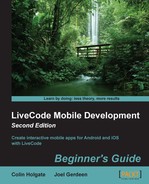Connect your Android and/or iOS device to your computer using USB. These instructions are almost the same as in the previous chapter, when we tested a "Hello World" stack. After this point, any directions will be briefer and based on the assumption that you know the steps needed to test an app on your device. Chapter 7, Deploying to Your Device, describes all the options in the Standalone Applications Settings dialog. For the moment, we're only going to fill in a few details, so here, we will just view a portion of the dialog, starting with the Android settings:

- Make sure that Android is checked in the Standalone Application Settings dialog.
- In the Identifier field, type in an identifier that will be unique;
com.yourname.lctestbedwould do. - Get your device to its home screen past the initial lock screen if there is one.
- In LiveCode, choose Development/Test Target and select your Android device. It will be named as Android followed by a long number.
- Choose the Development/Test option.
- After compilation, the stack should run on your Android device and you should be able to touch the Email button and perform a test message that will use the Android e-mail application.
On iOS, if you haven't already done so, read Chapter 7, Deploying to Your Device, on how to deploy to your device. At least read the parts that show you how to install your iOS developer certificates and provisioning files. As with Android, we're only going to alter a couple of items in the Standalone Application Settings. The following is the screenshot of the dialog that we'll be altering:

Perform the following steps for an iOS device:
- Change the Standalone Application Settings to iOS.
- Under Basic Application Settings of the iOS settings is a Profile drop-down menu of the provisioning files that you have installed. Choose the one that is configured for the device you are going to test the app on.
- In the Internal App ID field, type in a unique ID. As with Android,
com.yourname.lctestbedwould do.yournamewould of course be your name or your company name. - If you are testing on iPad, select the iPod, iPhone and iPad option from the Supported Devices drop-down menu.
- Close the dialog and choose Save as Standalone Application… from the File menu.
- When the saving is done, you may see a warning message telling you about missing splash screens and icons. It won't matter for now.
- In Finder, locate the folder that was just created and open it to reveal the app file itself.
- Open Xcode and choose Devices from the Window menu.
- You should see your device listed. Select it and if you see a button labeled Use for Development, click on that button.
- Drag the app file straight from the Finder window to your device in the Organizer window.
- The small colored circle next to the device will turn orange for a moment and then back to green.
- You can now open the app and try the Email button and test message, which will use the standard iOS Mail application.
We went through the steps needed to install the test bed app on both Android and iOS devices. We also had to change a couple of things in the standalone application settings. As you saw, there are quite a lot of settings in there. You can look forward to learning about them all in Chapter 7, Deploying to Your Device!
